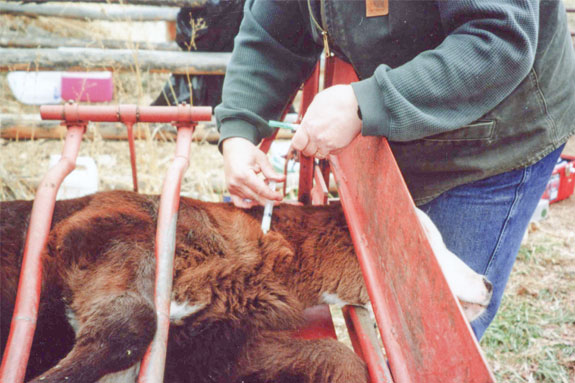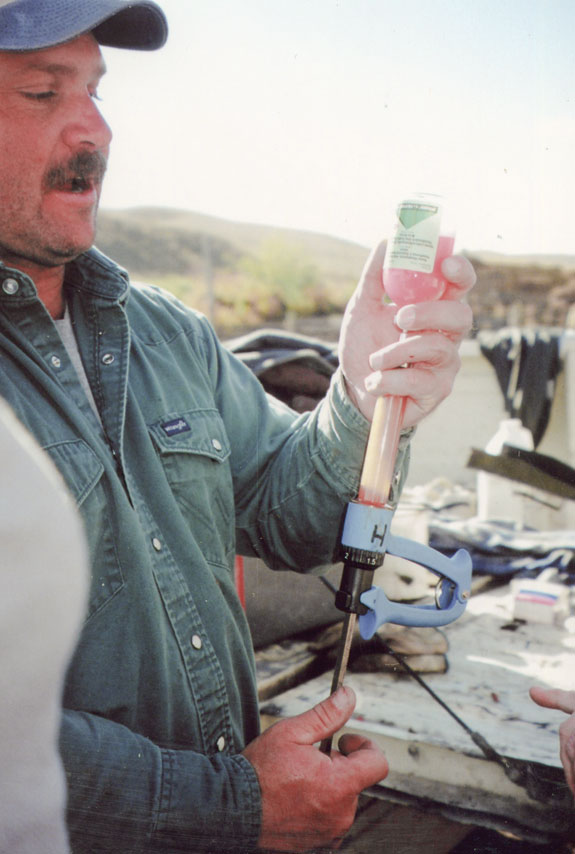After a few weeks or months, this temporary protection wanes, however, and calves must build their own immunities. Vaccinating calves at the proper time can help protect them until weaning age.
Vaccinating too soon may not stimulate much immune response. If the calf still has maternal antibodies in his system, these tend to interfere with building his own immunities. The body sees no need to respond.
Chris Chase of the Department of Veterinary and Biomedical Sciences, South Dakota State University, says there are several considerations to keep in mind.
“When maternal antibody protection begins to wane, we can probably get a good response to vaccinations by about 3 months old.
It all depends on how much protection the calf received at birth (how much colostrum, how soon – for maximum absorption of antibodies – and how good it was).
In most herds, you won’t find 100 percent of calves fully protected; it’s more like 70 to 80 percent,” he says.
Dr. Mark Alley, clinical assistant professor, North Carolina State University College of Veterinary Medicine, says we don’t know how much maternal immunity each calf gets, and it will wane at different times for each animal.
“It’s also different with each of the bacteria or viruses. Vaccine recommendations will be very dependent on what the potential issues are on each farm.” Each producer must plan a strategy to fit his/her own situation.
“When developing calf vaccination programs, we need to know what disease problems are going on in the herd,” says Chase.

If the herd has had issues with BRSV (bovine respiratory syncytial virus), for instance, this will necessitate a different plan than if the herd has not had problems.
New research is changing our ideas about timing of certain vaccinations. “One of the things researchers have discovered is that there are a few viruses – specifically IBR, BRSV and PI3 – that may not be blocked by maternal antibodies as much as we earlier thought,” says Alley.
“We may be able to vaccinate calves at an early age and still get an immune response. However, pathogens such as BVD, Pasteurella, Mannheimia, etc., may be blocked by maternal antibodies.
Vaccinating with these antigens should be discussed with your veterinarian before using them in young calves,” he says. As long as passive transfer is still strong, the calf may not build his own immunity to these in response to vaccination.
Some vaccines have been shown to provide immunity at an early age. Most of that research has been done by companies that make the vaccines.
“Some vaccines will provide some immunity for calves, even in the presence of maternal antibodies,” says Alley.
“The problem is that if we vaccinate a calf that has maternal antibodies present and come back later to pull blood to see if that calf responded to the vaccination, if we only look at antibody levels it may look like the calf did not develop an antibody response.
But then when immune protection starts to wane (at four to six months, depending on which pathogen we’re talking about), if we vaccinate that calf again with a similar product, we get an immune response similar to an animal that received a booster,” he says. There is some recognition and response to the vaccine.
“In our part of the country, producers usually don’t give vaccinations prior to weaning since they aren’t processing calves for any other reason (since they don’t have to brand),” says Alley.
“We’re trying to encourage people to do more vaccinating early – like they do in the West at branding time,” he says. Some producers may give the cows pre-breeding vaccinations, and this creates an opportunity to vaccinate the calves.
“Vaccination at some point during the first three months of life can be extremely beneficial and can reduce stress at weaning.
The calves are already accustomed to going through the facilities, and maybe we’ll get a better response to weaning-time vaccine,” says Alley. The earlier vaccination can set them up and the weaning vaccination acts like a booster.

“Some herds have trouble with summer pneumonia in young calves, and BRSV is a problem,” says Chase. “In these cases, there are two approaches.
One is to use intranasal vaccine, which has the ability to get around the maternal antibodies. The other thing a producer can do is use an adjuvanted vaccine.
In most cases people think that only an inactivated vaccine is adjuvanted, but we do have some adjuvanted modified-live vaccines,” he says.
“Some of the work we’ve done with inactivated vaccines shows that even after one dose of vaccine, we see some of the T-cells are turned on within two weeks of vaccination.
We see BVD antibodies coming up, even after 14 to 21 days, which is exciting, because we generally don’t see much of a response when we vaccinate with just one dose of inactivated vaccine (without following it with a booster).
To use just one dose would be off-label because we don’t have enough data to say you’d be safe with just a single dose,” says Chase.
“In most production schemes, it may be hard to give the calves a second dose. In many cases you’ll only have one opportunity to vaccinate them.
In this instance you’re stuck with using things with that kind of label – where we can give a single dose and gain adequate immunity,” he says.
“At this point in time the intranasal vaccine gives the most likelihood of success and the least likelihood of failure, in that age group.
From two weeks up to three months, this makes the most sense, particularly if you’re worried about BRSV. The adjuvanted modified-live vaccine, where you give a single dose, also has some usefulness, but I haven’t seen enough data yet in young calves with agents other than BVDV.
The intranasal vaccine, by contrast, has plenty of data to show that it works against BVDV,” he says.
“Another situation is when summer pneumonia might be due to Mannheimia hemolytica or Pasteurella multocida.
Producers might use either the live or inactivated vaccine. Studies indicate that even with inactivated vaccines there’s some maternal interference, up to at least 4 to 6 weeks old.
We have to consider what age the calves are having problems,” says Chase.
As a rule of thumb, most Western ranchers give calfhood vaccinations at branding time. “When vaccinating calves at this age, the goal is often just to prepare them for whatever they’ll encounter at weaning,” says Chase. It’s like a set-up vaccination that will be boostered at weaning. If you give a vaccination just prior to or at weaning, it’s good to have this initial shot at an earlier age.
Alley tries to convince producers about the benefit of doing vaccinations while the calves are still on the cow. “The calves are not as stressed and build better immunity.
If producers don’t do early vaccinations, we recommend they vaccinate calves two to four weeks prior to weaning. Calves should receive the viral and clostridial vaccines at that point.
This may or may not include pasteurella or pinkeye, depending on what the risk factors are for that herd. Then the calves get boosters at the day of weaning,” he says. ![]()
PHOTOS
TOP: When calves are vaccinated and still on the mama cow, it can reduce stress for the new animal and build stronger immunity.
MIDDLE: Vaccination for calves in their first three months shows several benefits in later months, especially around weaning time.
RIGHT: Since each farm has its own potential herd health issues, vaccination programs will vary by producer. Photos by Heather Smith







